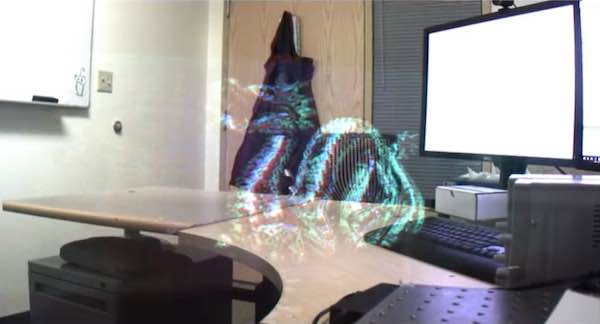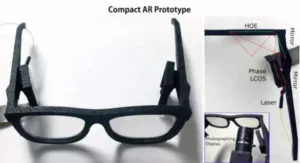Siggraph 2017 is shaping up to be a very interesting conference for holographic display enthusiasts. Just a little while ago Facebook / Oculus announced their work on a head mounted display system to overcome the vergence / accommodation issue, Microsoft is adding their view of the future of AR or mixed reality in their case. Andrew Maimone, Andreas Georgiou and Joel Kollin from Microsoft are giving a paper describing a phase only holographic projector based on a LCOS spatial light modulator. With a laser light source, this is getting very close to a true holographic display with full color and high resolution. Further, this device is also capable of projecting moving images.
To top it all off they also built a glasses-based prototype and show resulting images by using a camera instead of the eye. The following image shows what a user may be able to see through the optical element. The resulting images are completely free from any vergence / accommodation conflict, as the device provides the right focal depth on a pixel basis.
 Holographic image seen through a Microsoft glasses prototype
Holographic image seen through a Microsoft glasses prototype
While the image is not overly bright, compared to other attempts I have seen, this is actually pretty amazing considering that the image is taken in bright office environment. In other images they showed that the projection system is capable of reproducing one pixel wide structures in text.
The set up is definitely like a up prototype (thanks to 3D printing I assume), but compared to actual devices this is almost like the next generation of headsets not only by display performance but also by form factor.
Prototype of Microsoft Holographic Glasses
As one can see, the set up is more like a lab prototype just in a very small form factor. However, we can assume that the graphic processing unit driving the actual hologram is still a little too big to fit into the eyeglass frame. Nevertheless, Microsoft is making a big step forward in developing the next level of headset display technology that will eventually make all types of reality devices much more user friendly by avoiding display technologies that can induce nausea and other ill feelings.
For more information you can also watch a YouTube video describing the system in more detail.
It is needless to say that Microsoft is not saying it will ever release this or other devices of their research group as a consumer products, but this shows that they are at least working on it. (NH)

